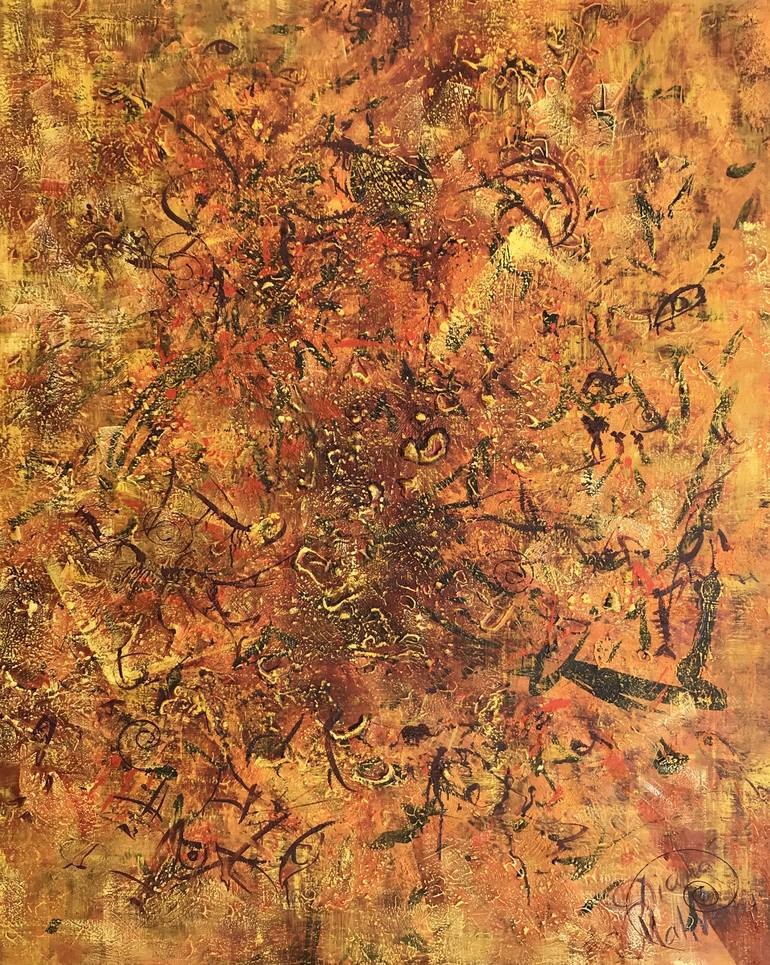







VIEW IN MY ROOM
The Sea of Samsara Painting
Cyprus
Painting, Oil on Canvas
Size: 47.2 W x 59.1 H x 1.6 D in
Ships in a Box
Shipping included
14-day satisfaction guarantee
Artist Recognition

Artist featured in a collection
About The Artwork
Collection «Large Format Artworks - Abstract & Surrealistic Art» * * * This artwork had deserved the Critique «Diana Malivani. "The Sea of Samsara". Artwork Analysis» by Christopher Rosewood, Art Critic and Member of the International Confederation of Art Critics (ICAC). * * * This artwork is part of the Art Project «Seeing The Invisible». We can hardly see the invisible; for example, those children’s puzzles which have objects hidden in a picture. We saw none of these things until we really began searching for them in unlikely places. They had been invisible to us, but before long we began to see the invisible. In her book “Exploring the Invisible: Art, Science, and the Spiritual”, Lynn Gamwell shows how modern science has transformed modern art and reveals that the world beyond the naked eye - made visible by advances in science - has been a major inspiration for artists ever since. In his book “Seeing the Invisible”, Michel Henry uncovers the philosophical significance of Wassily Kandinsky’s revolution in painting: that abstract art reveals the invisible essence of life and overturns our conceptions about art, because it seeks to express the internal aspect of phenomena, in other words, to paint the invisible. * * * The name of the artwork, «The Sea of Samsara» (part of the Art Project «Seeing The Invisible»), deals with Indian philosophical and religious traditions and means the endless ocean we must cross, lifetime after lifetime, to reach that far distant shore, termed in Buddhism Nirvana. Samsara is a Sanskrit word that means «wandering» or «world», with the connotation of cyclic, circuitous change. It also refers to the concept of cyclicality of all life, of death and rebirth, a fundamental assumption of most Indian religions. * * * More photos of the artwork as well as the relevant documents are available upon request (close-up views, the artists signature, in-context photos, publication copies, certificate of authenticity etc.).
Details & Dimensions
Painting:Oil on Canvas
Original:One-of-a-kind Artwork
Size:47.2 W x 59.1 H x 1.6 D in
Frame:Not Framed
Ready to Hang:Yes
Packaging:Ships in a Box
Shipping & Returns
Delivery Time:Typically 5-7 business days for domestic shipments, 10-14 business days for international shipments.
Handling:Ships in a box. Artists are responsible for packaging and adhering to Saatchi Art’s packaging guidelines.
Ships From:Cyprus.
Have additional questions?
Please visit our help section or contact us.
Cyprus
Artist Diana Malivani is represented by internationally reputable art galleries. Her works regularly appear in prestigious exhibitions and compete in art contests in several countries, are published in international art journals, offered for sale on leading online art marketplaces, listed by auction houses, and held in the collections of both national museums and private collectors throughout the world. Diana Malivani was born in 1976, in the USSR. She is a Doctor of Medicine by her training and profession (M.D., Ph.D). After many years spent in France, Diana now lives with her family in Cyprus. Artistic career Diana Malivani’s artistic oeuvre is characterised by a variety of thematic areas: flowers and still life, gardens and landscapes, animal and birds paintings, marines and abstract paintings, portraits and genre scenes, religious and Indian themes. The dominant themes of the artist's works include flowers, gardens and landscapes, created in the author's own style, combining impressionism and realism. Malivani’s abstract compositions are grouped into several art projects: ’Seeing Music’, ’Seeing the Invisible’ etc. Almost all Malivani’s works are made in the technique of oil on canvas, mainly with a palette knife. The works, part of the art project ’The Blue Butterfly’s Dream’ (semi-abstract surrealistic compositions and woman portraiture) are characterized by a mixed technique: oil painting on fluid acrylic background and gold leaf collage. Malivani’s artworks are held in the collections of some National Art Museums in the Russian Federation (in the cities of Sochi, Belgorod, Saransk and Novokuznetsk). Awards & Prizes Malivani is part of the List of the Best Contemporary Russian Artists by ARTEEX, art marketplace and information platform in Russia. Her landscape painting ’Les jardins de Giverny’ was awarded with the First Prize in the Category ’Painting - Realism’ at The Global Art Awards at Shanghai International Art Fair 2020. Her semi-abstract painting ’Pearl Fisher’ was awarded with the Second Prize at London Art Biennale 2019, and two figurative paintings - ’Sparrows’ and ’Dance of Pink Flamingoes’ - became Finalists of The International Artist Grand Prize Competition 2020 in Taiwan.
Artist Recognition

Artist featured by Saatchi Art in a collection
Thousands Of Five-Star Reviews
We deliver world-class customer service to all of our art buyers.
Global Selection
Explore an unparalleled artwork selection by artists from around the world.
Satisfaction Guaranteed
Our 14-day satisfaction guarantee allows you to buy with confidence.
Support An Artist With Every Purchase
We pay our artists more on every sale than other galleries.
Need More Help?